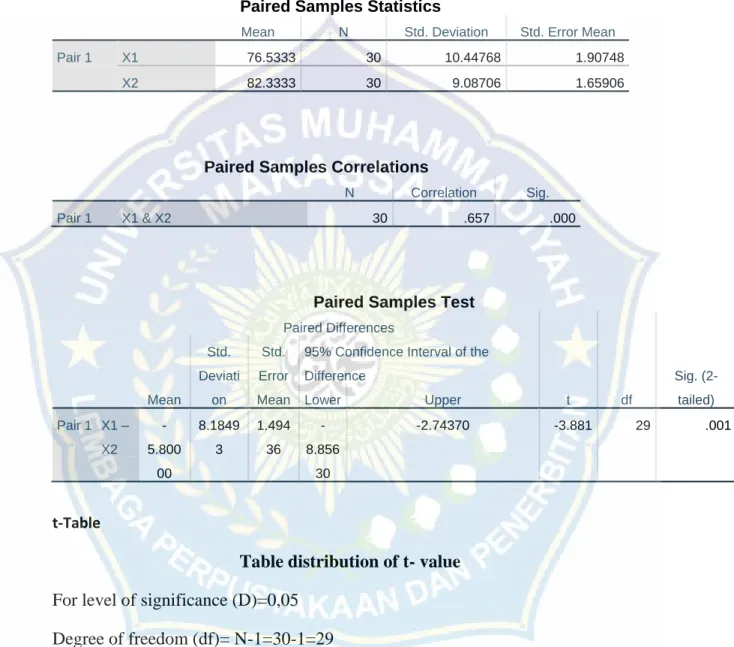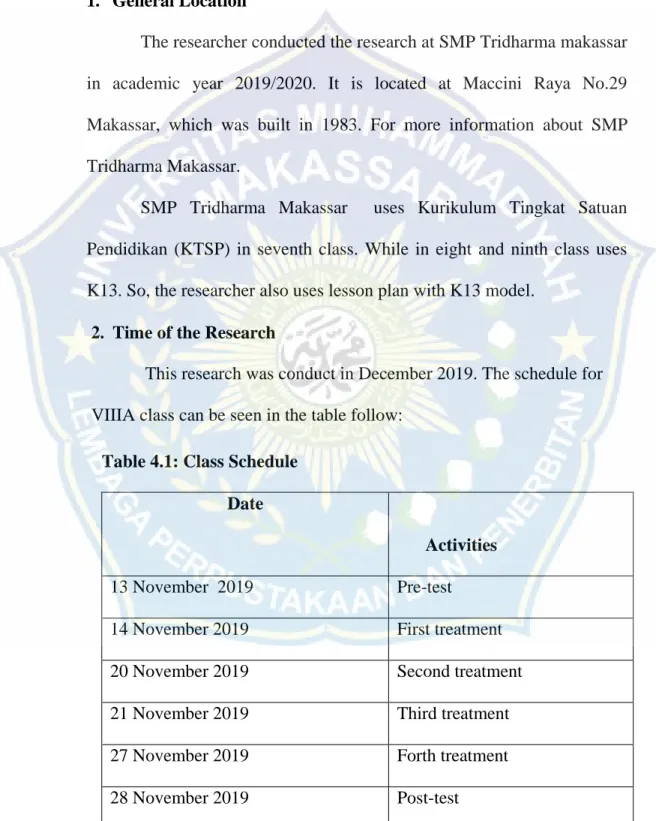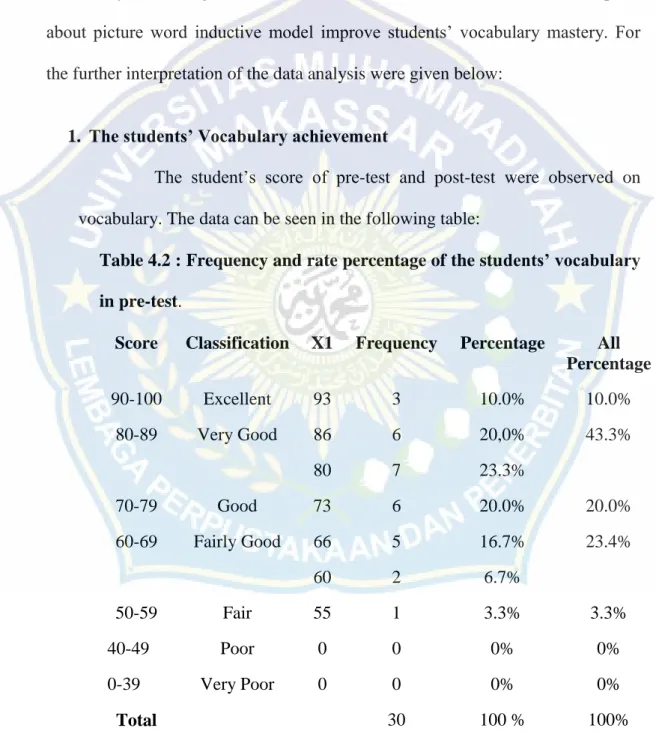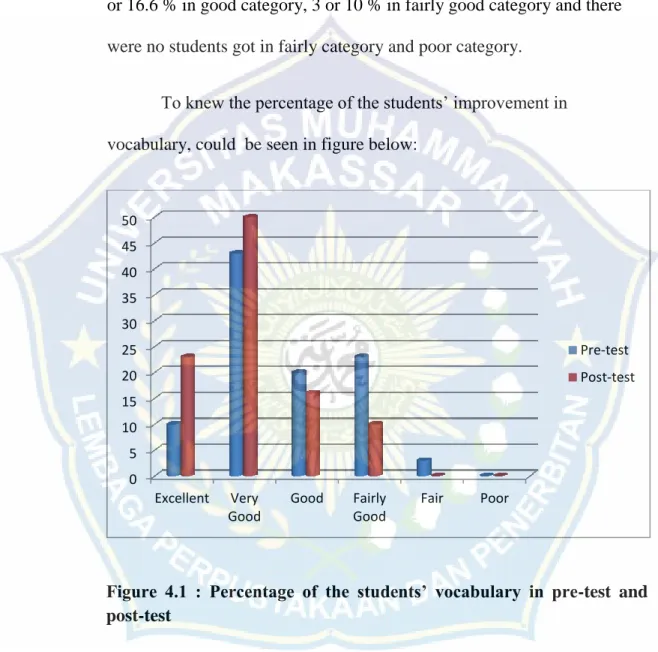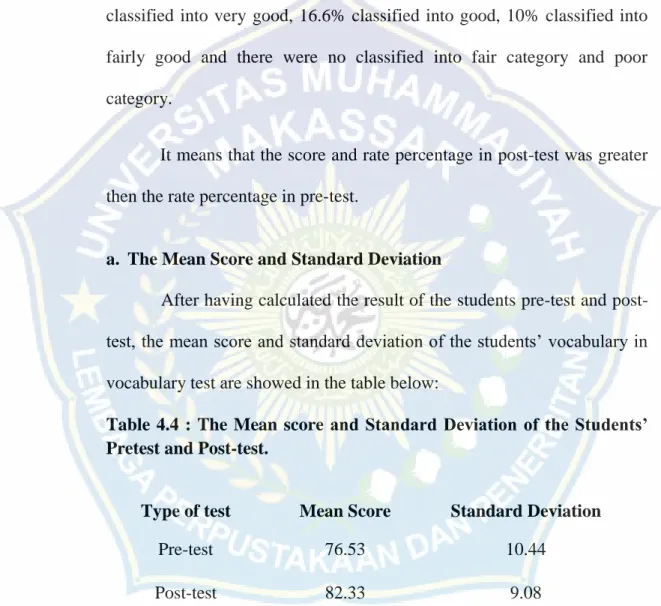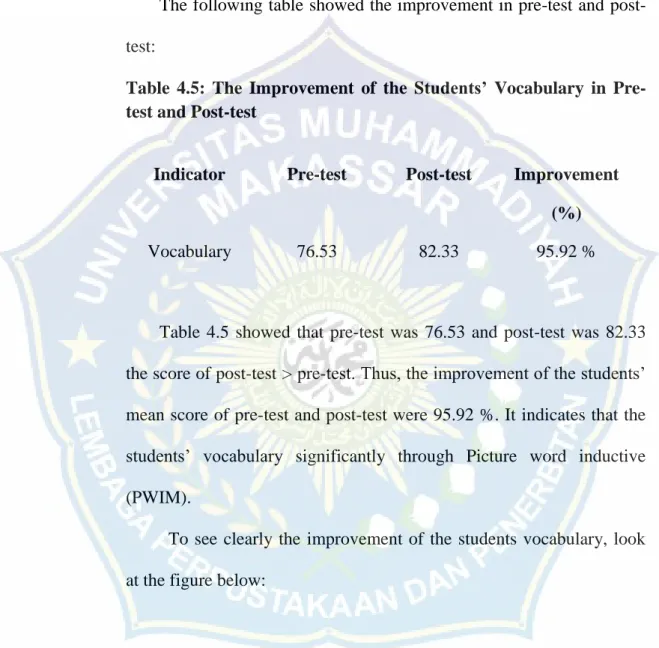The effectiveness of using figurative word inductive model (pwim) in improving students' vocabulary mastery in grade eight (A-Pre-experimental Grade VIII SMP Tridharma Makassar). Asmayanti AM, S.Pd., M.Pd, as her proposal examiners who have provided useful knowledge and experience. 37 Table 4.3 Mean score and standard deviation of pre-test and post-test of students………….
Appendix C Scoring of the students' correct answer of pre-test and post-test Appendix D Classification of students' score. Appendix G The frequency and percentage of students' vocabulary (SPSS) Appendix H The significant difference between pre-test and post-test (SPSS) Appendix I Name list of VIIIA STUDENTS' SMP Tridharma Makassar Appendix J Documentation.
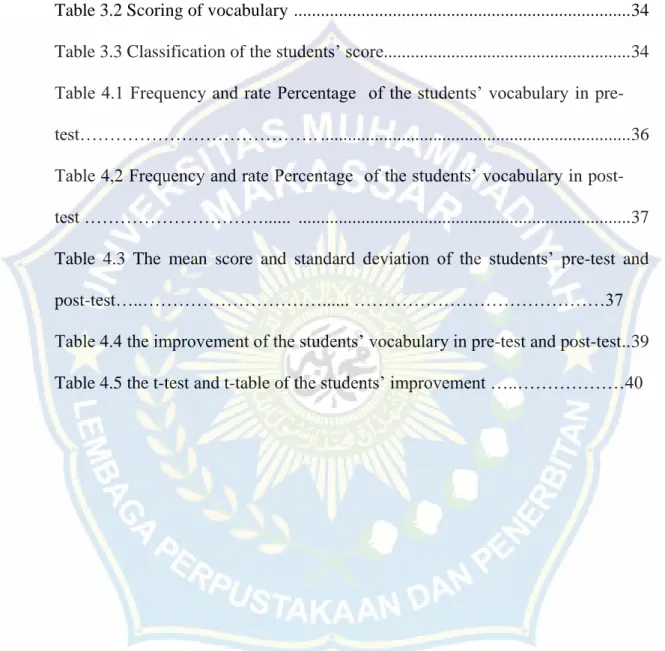
INTRODUCTION
Problem Statement
The second research was carried out by Siti Marfuah with the research title "The Use of Picture Word Inductive Model to Enhance Vocabulary Mastery (A Classroom Action Research of the Second Grade Students of Vocational School of AlFalah Salatiga 2013/2014") The third research was carried out. by Nita Alfi Nur Rohmah with the research title "The Effectiveness of Picture Media toward Vocabulary Mastery. The fourth research was done in 2017 by Devi Suraya, Dewi Novita, Ana Fergina with the title "The effect of using picture word inductive model on teaching descriptive text writing “Using PWIM emphasized more how students recognized the words by looking at the pictures provided by the teacher.
Improving Students' Ability to Write a Descriptive Paragraph” The focus of this research was to find out the effect of using the Picture Word Inductive Model (PWIM) to write a descriptive paragraph. Devi Suraya, Dewi Novita, Ana Fergina in 2017 titled “The effect of using picture word inductive model on teaching descriptive text writing” The use of PWIM placed more emphasis on how students recognized the words by looking at the pictures the teacher provided . Aulia Haning Setyorini in 2016 with the title "The effectiveness of the word inductive model (picture word inductive) in learning to write poetry in grade VII students in SMP Negeri 1 Sentolo, kulon progo".
In the treatment of four meetings with the picture word inductive model (pwim), which the first meeting discussed about the English vocabulary material in the classroom used the picture and the videos, the second discussed the vocabulary in the classroom with the connected material "Aking and giving Meaning", the third discussed about the picture again in the classroom, the fourth discusses about the vocabulary with the connected material “agreement and disagreement” and made their creativity about the funny pictures.
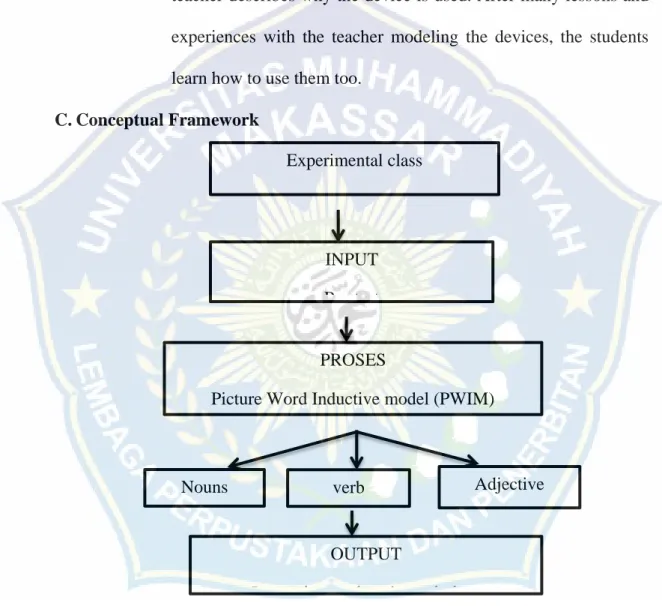
Objectives of the Research
Significances of the Research
Students hope that students can improve their vocabulary through the Inductive Word Picture Model (PWIM) and develop their study in order to be successful. The teacher can use the result of the study as feedback on the teaching activities and it will improve his performance in the teaching program. This research is expected to contribute to the readers, especially the students of SMP Tridarma Makassar in enriching the references related to the use of Picture Word Inductive Model (PWIM) to develop students' vocabulary mastery.
Scope of the Research
The result of her research showed that there was an improvement in students' vocabulary mastery using the inductive picture word model. The problem statement is “Was there any improvement in the student's vocabulary mastery before and after using the picture-word inductive model (PWIM)?”. Scoring of students' correct answers before and after the test Table 3.1 Scoring of the test.
In other words, the use of picture word inductive model (pwim) improves the students' vocabulary mastery of the eighth grade of SMP Tridharma Makassar in the academic year 2019/2020. However, after applying the picture word inductive model (pwim), the students could answer the test vocabulary with true and also know the meaning of the word. It means that there was an improvement in students' vocabulary mastery before and after used picture inductive model (pwim) for students' vocabulary mastery of the eighth SMP Tridharma Makassar.
Using the picture word inductive model to improve the vocabulary mastery of the second grade student of alfalah salagi vocational school.
Previous Related Research Findings
Some Pertinent Ideas
The description of students' vocabulary with the result of data previously explained in findings and the description of students' vocabulary between pre-test and post-test. Before using the picture word inductive model (pwim) as an English teaching medium, the students could not answer the test vocabulary with false and did not know the meaning of the word. A conceptual paper on the application of the picture word inductive model using Bruner's constructivist view of learning and the cognitive load theory.
Conceptual of Framework
Hypothesis
According to Ali, a hypothesis is the formulation of a provisional answer that the researcher's activities are supposed to put forth.
RESEARCH METHOD
- Research Variable and Indicators
- Population and Sample
- Research Instrument
- Data Collection
- Data analysis
At the beginning of the lesson, the researcher opened the lesson by greeting and checking the attendance list of the students. Then the researcher will guide the student to mention the vocabulary as much as possible that their knowledge then show the picture word inductive model to the students than to explain what is picture word inductive model, the. Furthermore, the picture word inductive model will be given to the students and they will be instructed to find out as much as possible the vocabulary that they know in the picture word inductive model within 15 minutes.
Before the lesson begins, the investigator says the greeting and checks the student's attendance list, then moves on to the next material. As usual, at the beginning of the lesson, the investigator opened the lesson by greeting and checking the attendance record of the students. The research will explain verbs and adjectives, provide examples through the picture word-inductive model. Sometimes the researcher will ask the students to show part of the verb in the picture word inductive model and then the student will be assigned to memorize 5 vocabulary words with the meaning in the picture word inductive model.
The researcher will open the lesson by greeting and checking the attendance list of the students and then review all the materials from the beginning to the last meeting. Then the researcher distributes the inductive model of the figurative word and tasks the students to find 5 nouns, verbs and 5 adjectives in the inductive model word. On the other hand, the students' vocabulary text in the post-test was better than the pre-test.
Therefore, it means that the picture word inductive model in the treatment of students' SMP Tridharma Makassar was successful in letting the students know what the spelling of the word means, also that the students are more interested in learning process because the students could make their creativity. This was proven by the students' average score improving from pre-test to post-test.
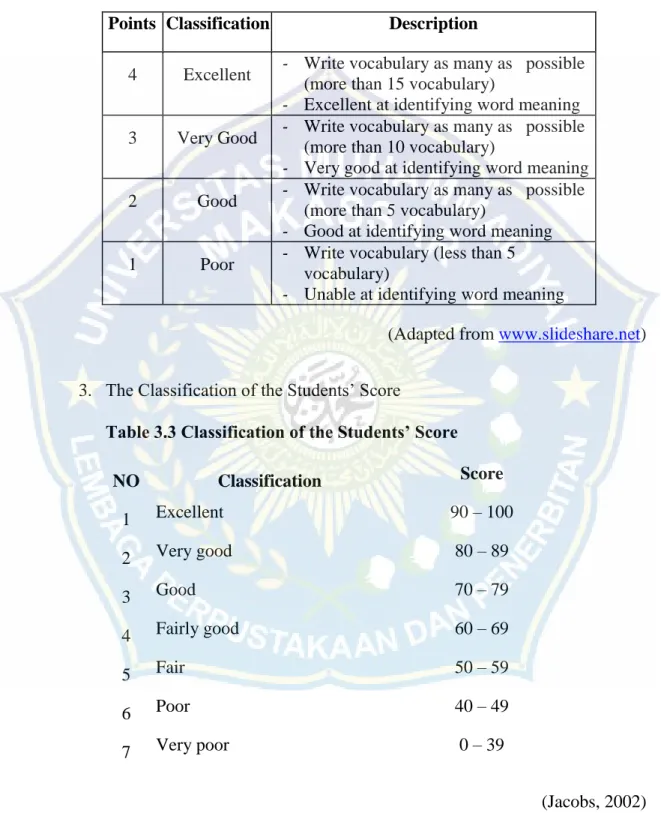
FINDING AND DISCUSSION
Findings
To find the answer of the research question, the pre-test was given to find out the students' vocabulary first before explaining the inductive model of figurative words in the classroom and the post-test was given to find the improvement of the student's vocabulary after doing. treatment which aimed to know if the explanation about the inductive model of figurative words improves students' vocabulary mastery. 15 or 50% of students in the very good category, 5 or 16.6% in the good category, 3 or 10% in the fairly good category and there were no students in the fairly good category and in the poor category. It means that the score and percentage of the norm in the post-test was greater than the percentage of the norm in the pre-test.
Very good) with standard deviation 9.08 This means that the mean score of the post-test was higher than that of the pre-test. To know the level of significance of the pre-test and post-test, the researcher used the t-test analysis at the level of significance (p) + 0.05 with the degree of freedom (df) = N-1, where N= the number of subject (30 students) then the value of the table is 2.04523.

Discussion
Eksplorasi - Siswa belajar menggunakan cara bertanya dan memberi pendapat dengan melihat dan mengamati gambar-gambar yang tersedia. Siswa berusaha mencari informasi yang diberikan guru tentang ungkapan mengungkapkan pikiran dan pendapat dengan menggunakan gambar yang diberikan. Siswa menindaklanjuti jawaban - Secara berpasangan, siswa melakukan percakapan berdasarkan ekspresi mengungkapkan pikiran dan gagasan dengan menggunakan gambar.
Siswa dapat menggunakan percakapan tentang mengemukakan pendapat, pendapat dan pemikiran dalam kehidupan sehari-hari. Menanya - Dengan bimbingan dan bimbingan guru, siswa bertanya antara lain perbedaan berbagai ungkapan pendapat dan pemikiran, setuju dan tidak setuju, tergantung konteks penggunaannya. Siswa mengenal dan membuat dialog tentang pengungkapan pendapat dan pemikiran, persetujuan dan ketidaksepakatan dalam kelompok.
Asosiasi - Dengan bimbingan guru, siswa berdiskusi dengan kelompoknya untuk berdialog tentang apa yang pantas antara gambar dan ungkapan pendapat dan pemikiran, setuju dan tidak setuju. Komunikasi – Siswa melaporkan hasil kerja kelompok secara lisan mengenai ungkapan pendapat dan pemikiran, persetujuan dan ketidaksetujuan. Siswa mengungkapkan hal-hal yang sulit dan mudah dilakukan berkaitan dengan materi mengemukakan pendapat dan pikiran, setuju dan tidak setuju.
Bertanya - Dengan bimbingan guru, siswa bertanya bagaimana cara membuat gambar dan dialog kreatif sendiri. Komunikasi - Siswa melakukan dialog tentang ungkapan bertanya dan memberi pendapat, setuju dan memilih sesuai gambar. Siswa menyampaikan kepada guru manfaat, tujuan dan makna yang terkandung dalam ungkapan pendapat dan pemikiran, persetujuan dan ketidaksepakatan.
CONGLUTION AND SUGGESTION
Suggestion
Guru memberikan motivasi belajar siswa dalam konteks, sesuai dengan manfaat dan penerapan materi pembelajaran dalam kehidupan sehari-hari. Komunikasi - Siswa berdialog tentang ungkapan pertanyaan dan memberikan pendapat sesuai gambar yang diberikan - Siswa mempraktikkan dialognya di depan kelas. Asosiasi - Dengan bimbingan guru, siswa mencocokkan struktur kata yang akan dijadikan judul gambar.
